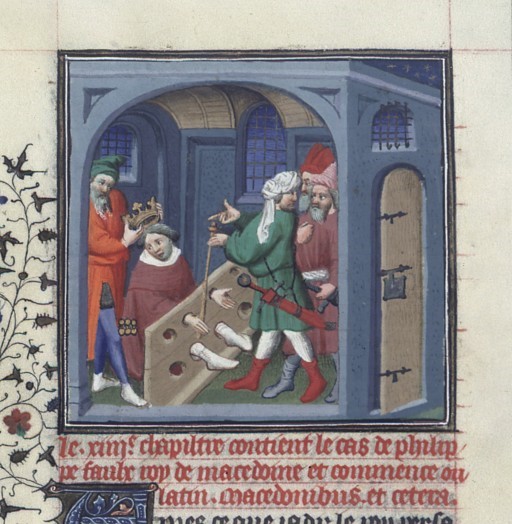Executioners, policemen and parents punished domestic violence with whipping and stocks in the Valencian Middle Ages
- Scientific Culture and Innovation Unit
- April 5th, 2022

What was domestic violence like in the Middle Ages? Was it legally regulated or did it concern only the privacy of each family? The researcher from the University of Valencia Alberto Barber has analysed “punishment licences” issued by the Criminal Justice of the Kingdom of Valencia in the fourteenth and fifteenth centuries that legislated the sanctions for these attacks. Among others, whipping and chaining by means of stocks were authorised and the forms of punishment were carried out by the head of the family or by members of the urban security body (saig) or specialists in physical punishment (morrodevaques or botxí).
According to Barber, “we do not know the reason why individuals went to the Criminal Justice court to request the application of these corrective measures in the private sphere, since the legislative system and the patriarchal ideology authorised them, in a context of already violent social customs”. In addition, it is unknown whether these measures can be extended to the rest of the Iberian Peninsula and Europe, given the scarcity of sources and studies.
As long as they did not involve serious injuries or bodily amputations (a fact that would be returned to the causer under the Talion Law), the punishments were conceived as a “feudal right” useful for correcting deviations. Thus, disrespect or harmful actions for the family were harshly repressed by the father or the lord of the house. In this sense, licenses can be found to carry out up to 50 lashes because of a theft. In the case of the slaves, the sentences were so severe that they even ended up assuming crimes they had not committed.
Studies on the exemplary character of private medieval punishments are scarce in the scientific literature. In his article Per via de càstich e correció: violencia domèstica i llicències de càstigs a la València Baixmedieval (1384-1456) published in the magazine Aragón en la Edad Media (number 32), Alberto Barber has recovered twelve books of cédulas (legal records where complaints, defendants’ statements and oaths of office, among other data) made by the criminal courts of the Kingdom of Valencia between the years 1384 and 1456 were recorded. Specifically, the researcher has studied 117 punishment licenses.
The corrective measures registered in the licenses were two: the retention by means of stocks and the application of lashes with a whip. Quite a few images and drawings of the stocks are preserved, and they were made of wood. On the other hand, we know very little about the whip as an instrument, but according to some drawings that have been preserved, it is intuited that these would have between five or six tails, with a ball or knot at the tip of each one of them.
In the case of whipping, members of the urban security body (the saig) or specialists in physical punishment such as the executioner, called morrodevaques or botxí, could be resorted to. However, in many cases it is not specified who should carry out the punishment, and the executor may be the father or lord of the house.
For its part, the way of whipping varied according to the context. One can gather that women, for example, being considered in the same jurisdictions as beings more “weak” than men, received less intense blows. Similarly, the so-called “insane” (people with mental health problems) were not considered responsible for their actions and, therefore, could not receive disapproving punishments. On the contrary, whether they were considered agitated and dangerous people or simply dependent, the penalties consisted of retention by means of stocks, chains or shackles, in no case physical punishments such as whipping. Thus, an attempt was made to put both third parties and the “insane” themselves out of risk.
Family members were also punished for reasons of flight, although the causes are largely unknown. Immobilisation was, once again, the most appealed sentence, despite the fact that other punitive measures linked to physical punishment are not ruled out. Those members captured in flight (for example, slaves) could spend from 8 days to 6 months chained with a trap, although the average time of punishment ranged between 1 and 2 months.
Violence towards slaves
Slavery in the Christian Mediterranean area and, specifically, in Valencia at the end of the fourteenth century and during the fifteenth century, was a widespread practice with a mainly labour sense. Both slaves and macips were considered members of the same family nucleus. The numerous escapes of these are understandable if we take into account the harsh working conditions to which they were subjected from an early age (between 7 and 12 years).
Most macips and slaves were insured by law and could only be punished for a justified reason. In this sense, despite the many criticisms of the dissatisfied masters, it was not possible to whip freely for personal reasons (grudge, relief, etc.), at least legally. Be that as it may, the lack of documents that record extralegal punishments does not mean that these could occur normally.
Article: Barber Blasco, A. (2021). “Per via de càstich e correcció: violència domèstica i llicències de càstigs a la València baixmedieval (1384-1456)”. Aragón En La Edad Media, 32, 7–29. DOI: https://doi.org/10.26754/ojs_aem/aem.2021326212
Photo caption:
1. Alberto Barber, researcher of the University of Valencia.
2. Transcription of a punishment license: “L’onrat en Bernat Borrell, regent l’ofici de Justícia Criminal, l’onrat en Francesch Aguilar, Justícia dessús dit, dóna licència an Bernat Miró, blanquer, que pogués fer donar per rahó de càstich a Bernada, sclava sua de linatge de moros, XX açòts per Francesch Urgellés, saig, per via de càstich e correcció”.
3. Example of torture with stocks. Andriscos emprisonné, Bibliothèque nationale de France, Département des Manuscrits, Division occidentale, Français 226, fol. 145v
File in: Investigació a la UV , Facultat de Geografia i Història , Producció científica , Difusió i comunicació científica , Internacionalització recerca




















